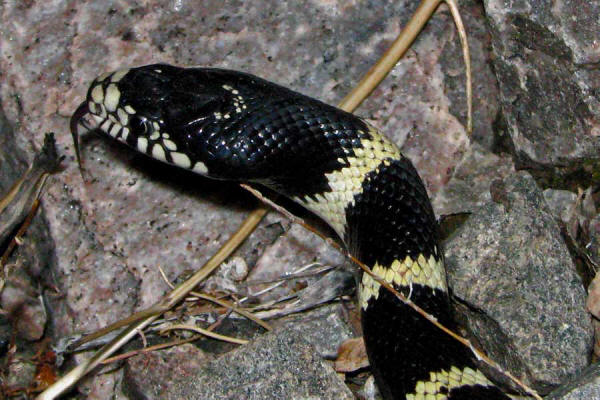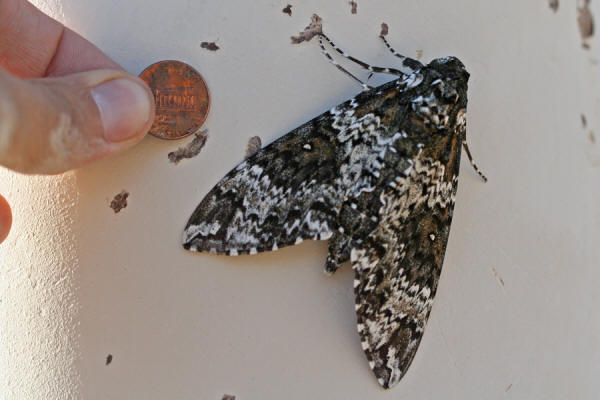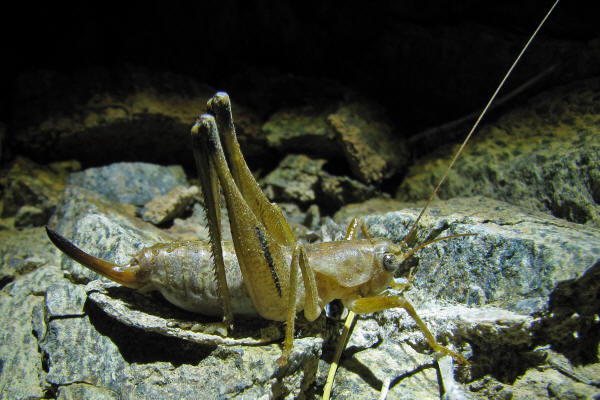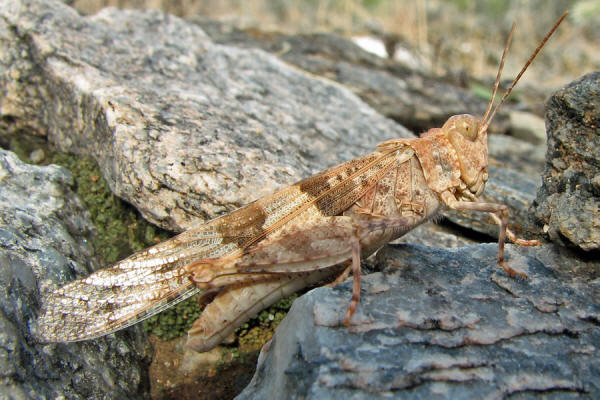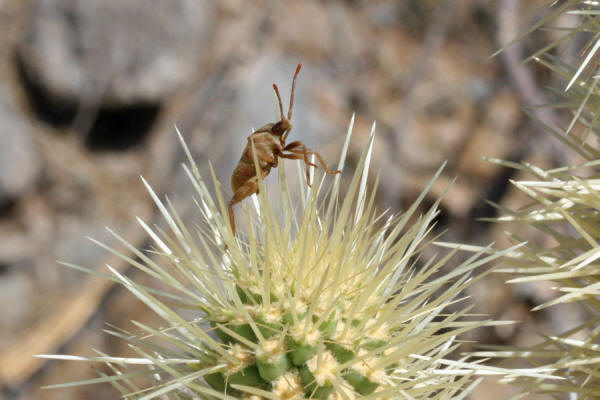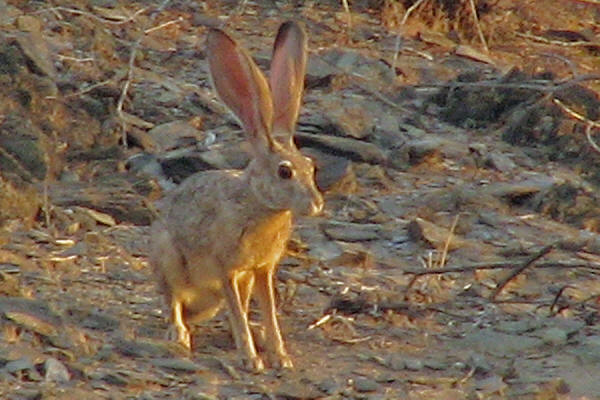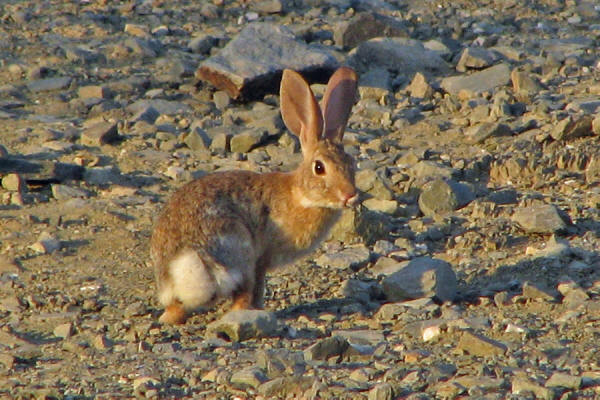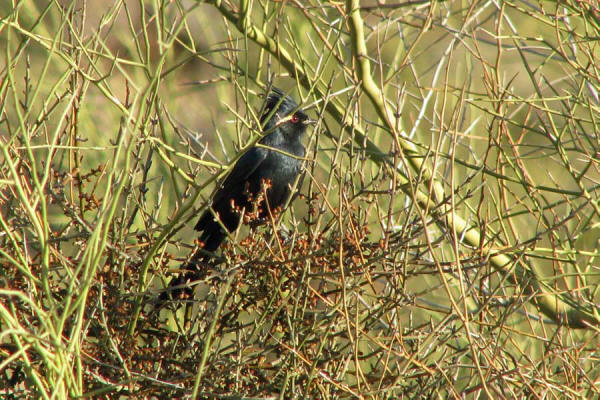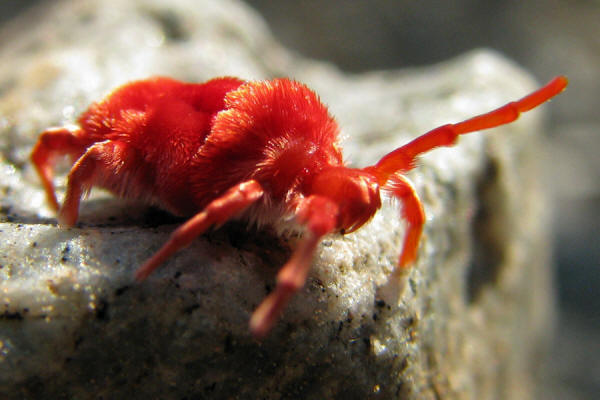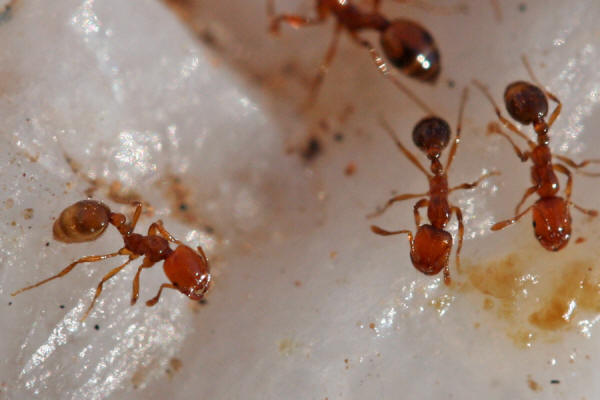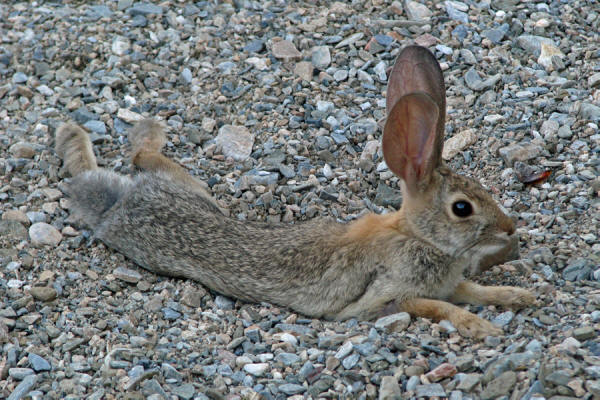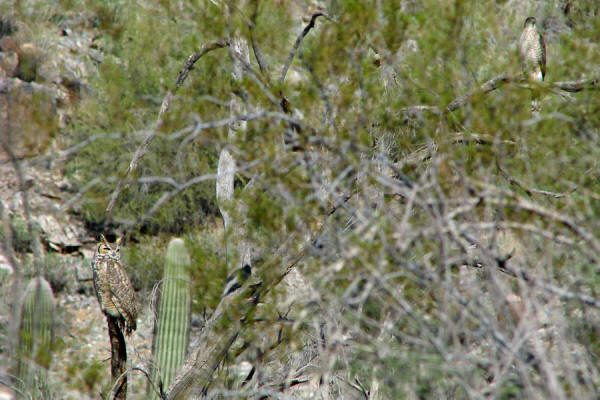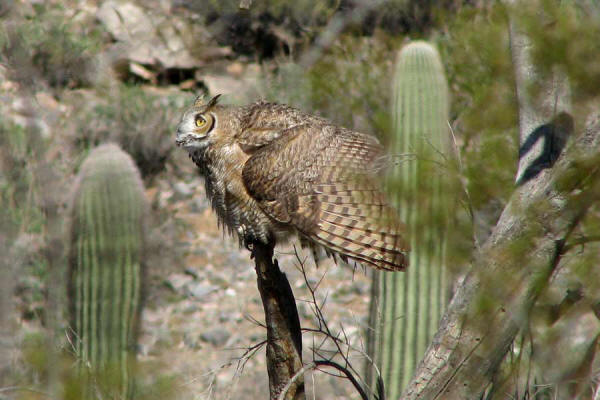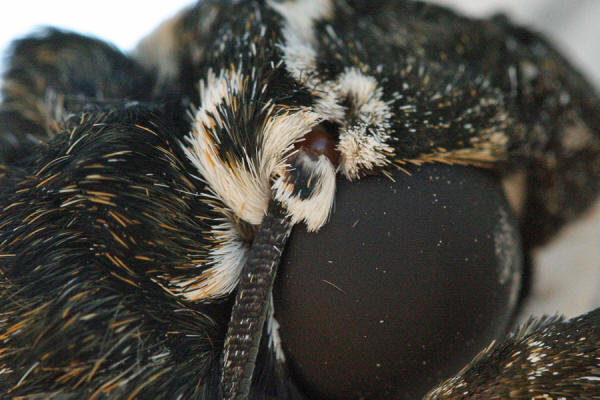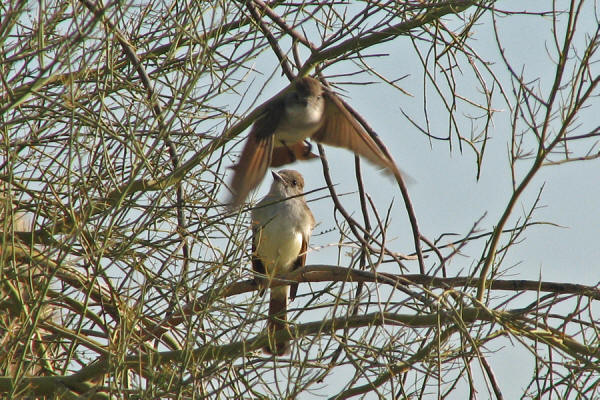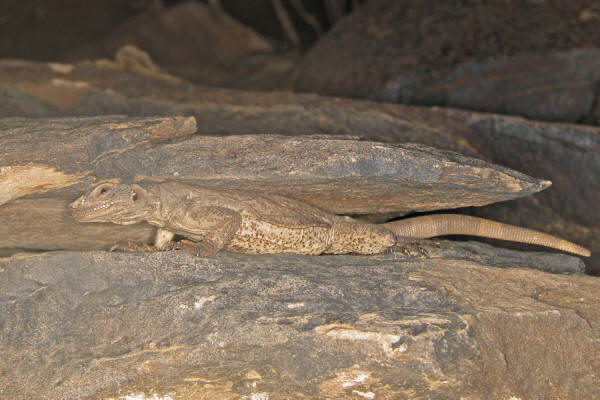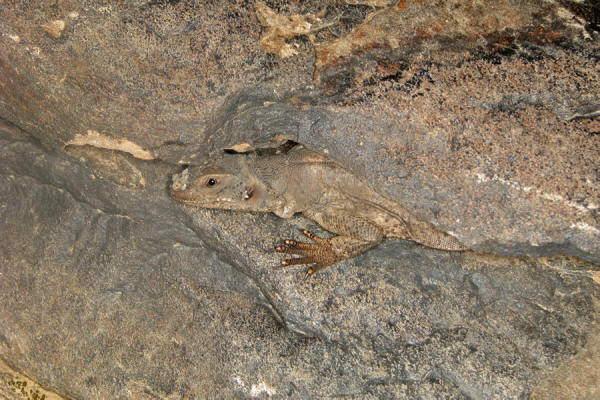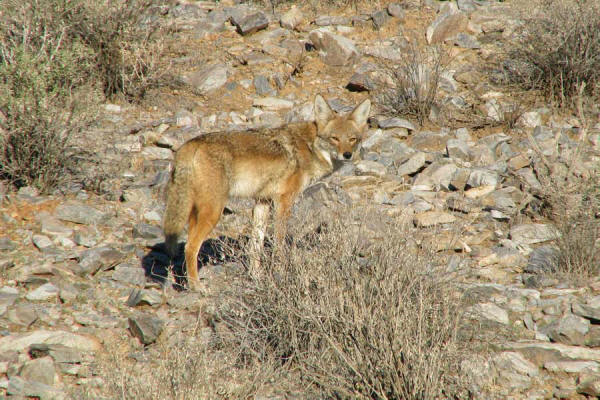AZJoe
- A peak into the beauty and wonder of the Sonoran Desert in Phoenix
Home Daily page 2 Daily page 3 email: arzjoe (at) gmail.com
Gotta love the Californians, at least some of them! I was most pleased to cross paths with this beauty the other night. He(?) was a little skittish at first, then warmed right up to my presence, going on as though I wasn't even there, with my flashlights and camera flash. We hung out for about an hour, during which he covered quite a lot of ground. At one point he scared the poof out of a little mouse, who quickly bounded away.
In researching these creatures, I was quite surprised to find out that they love to eat rattlesnakes! Now that would be quite a dining experience to behold...
Rustic Sphinx Moth
This is certainly the biggest moth that I have ever seen.
It was hanging out on one of the light poles by the Rangers Station.
I love the myriad of designs on his back. It get even more intense the closer in you go.
Click for more info on the Rustic Sphinx Moth
Not your average residential Cricket
This cricket looks like a warrior, with all those spikes.
Look at how huge those legs are! They are almost as high as he (?) is long, and that is just one section, What an impressive array of spikes he has going down the back of the legs, topped off with an subtle racing stripe.
The appendage in the abdomen looks like a huge stinger, but upon closer inspection it looks flexible. Where it connects to the abdomen are 3 or 4 spikes, reminding me a bit of Triceratops.
When I was shooting this critter, I had to get my camera down very close. Then I noticed how long one of the antenna is, so I had to be careful not to bump into it, and maybe set him off. And with those extra-long legs, he would likely jump a long way, out of my sight, at least at night. Thanks...
click the image to see the amazing detail
Black-tailed Jackrabbit at sunrise
This critter belongs to a species that can be very easy to spot in the wild. With those extra long ears and legs, anytime this animal is on the move, spotting is easy. Looking at the Cottontail below, one can see lots of similarities and difference. The Jackrabbit kinda looks like a stretched version of the Cottontail.
The Jackrabbit reminds me of the wallaby or the kangaroo. The huge hind legs are very familiar. I have watched and photographed these rabbits standing on their rear feet and boxing, just like the kangaroos. One big difference; with the Jackrabbit, the boxing was very quick and over, too fast to register what happened. When I photographed some boxing Jackrabbits several years ago, and was stunned by the boxing precision that I saw in the captured images, all in a split second. One day I will share the series on Jackrabbit boxing. I am thinking of calling it "Fight Club Jack" : )
Cottontail Rabbit showing off the cotton
These furry little animals are tough, fast, and quick. They will eat Cholla cactus if they are thirsty enough. They can outrun any human, and they are quick enough to evade many a coyote.
They also love to play games with each other, beyond the usual chase. One game could be called Split Jump; Two cottontails face one another, about 6 feet apart. Suddenly one runs right at the other, at high speed. The other rabbit just sits there and waits. At the last moment, the second rabbit springs straight up into the air, and the first rabbit runs right underneath. I have seen them do this many times in a row.
This type of play shows the fun and joy that animals experience in the wild. Observing them using their physicality and reactions at such a high level reminds me of playing spontaneous games as a child. Aah the bliss of it all : )
Phaenopepla, male
It has been a while since I have heard the distinctive whistle of these black beauties. It reminds me of someone trying to get your attention with single loud mid-tone whistle. It feels a bit like they are saying "over here".
This bird is shown perched in the middle of it's favorite food, mistletoe berries. Kissing aside, this stuff is a killer, a parasite that sucks the life out of trees. One of the favorite victims are Palo Verde trees. Sometimes it takes the whole tree down, and sometimes just the main branch.
This bird spreads Pt by pooping viable mistletoe onto the branches, where it gets active.
Velvet Mite
The Velvet Mites are quite the mysterious characters. They only seem to come out after the rains in the summertime, and only sometimes. I didn't see them at all last year. After the big rain we had the other day, they made an appearance. Hooray for the underground dwellers that make a rare appearance for us to enjoy.
Click on the photo for a larger version. recently, alas they made an appearance.
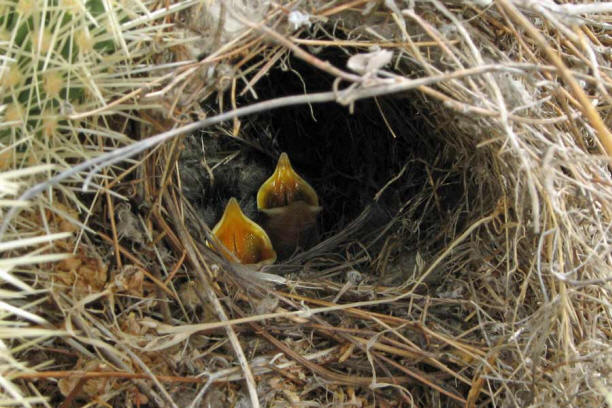
Spring was certainly active in the park, with babies in nests all over. I was a bit surprised to these little critters this late in the season, in early June.
It seems like the mortality rate for the little ones is high in the park, with many being taken by other birds. It feels harsh, but the balance of nature goes well beyond my feelings and thoughts. Even so, there appears to be plenty of these great birds gracing the land with their presence.
Tiny Ants doing their thing
These are some of the smaller ants, about the size of a small grain of rice. They are some of the busier critters in The Park. One of their main jobs is cleaning up messes left by other animals. Here they are taking in the remains of an odd gelatinous mass that I encountered...I am not sure what it was or who was responsible...it was a new site for me. It was on a rock and was about the size of a hot dog cut in half. When I came back later, it was gone, and I then photographed the ants. It seemed like something that an animal ate, then it came back up, was left out, then was eaten again. My best guess is a coyote.
The Park is full of mysteries : )

- Bee gorging on Barrel Cactus bloom yummies.
This leaf cutter bee is partying hard in this saturated sun-like blossom. I have never noticed a tongue on a bee before, much less a split tongue, or maybe it is even 2 tongues.
These creatures are hugely impactful for the well being of us human animals. Without bees, many of our crops would not produce fruit. We would have to do what a village in China does for its apple trees; they hand pollinate each blossom.
These are another great example of the genius design of our earth, of how things work that are far beyond us, and that need to be honored and respected.
Cottontail
This furry beauty was cooling off and relaxing during the late afternoon. I love how he just flops his feet back behind him, getting his whole under-region in contact with the earth.
Today provided quite a treat...an encounter between a couple of raptors that live in The Park.
First I saw a large Great-horned Owl perched in a snag. All of a sudden she(?) started fluffing up and squawking loudly. Why? Because a Cooper's Hawk had flown into the same snag. Apparently the Owl had come a bit too close to the Hawk's territory, likely close to the nesting area.
Here is a photo of the two of them in the tree...the Owl in the lower left corner and the Hawk in the upper right corner.
Here is the Owl getting all worked up because the Hawk just landed in the same tree. The owl started making a bunch of noise, but the Hawk didn't seem to mind at all. In fact, the Hawk flew in closer to the Owl.
Here he(?) is, about to move in closer to the owl. His tenacity on driving the Owl out was most impressive.
The Hawk ended up chasing the Owl out of the snag and about 100 yards away. A bit later the Owl flew again, with the Hawk right behind. This happened several times.
Antennae socket
This is one of the most important parts of this critter; an eye and an antennae socket.
What kind of critter is this?
It is a Rustic Sphinx Moth, about the size of a closed fist.
There is an image below for scale.
This is the only time I have seen this critter, and boy did he stick out.
Click on the photo to see the fine detail of an eye and antennae socket.
I love the colors of the "hairs", and how they are distinctive yet blend very nicely. I also love the wavy patterns, like a flowing river, with areas of turbulence and everything.
Fun...
A pair of Ash-throated Flycatchers
These birds are one of several different types of Flycatchers in The Park. They are elegant and acrobatic flyers, and are a lot of fun to watch.
Chuckwalla hanging out under a rock
This lizard was well hidden as I strode by. I only saw him because his front foot was sticking out from under the rock a little, and he moved it.
These reptile spend a lot of time in crevices and under rocks like this. They seem to feel most comfortable in situations that would seem way too tight for most other animals.
I love how they seem to take on the color of their surroundings. It almost seems like they can do that Chameleon thing. Not sure if they can change their coloration even a little.
I have another idea of how they have such genius camouflage. I think that they stay in the same areas for generations. The first ones in slowly adapted their coloration to match their particular surroundings.
Same Chuckwalla hanging out under a rock
When I first saw him, all I could see was that front foot. It is considerably darker than the rest of the leg, so it stood out some.
If you click on the photo, the large version better shows the wonderful camouflage abilities of this critter.
Chuckwallas can have a wide range of color variations, even in the same area. Some are brightly colored while others are very muted, like this one.
I wonder how much this species has changed in the past 1 millions years. Maybe that is a short time in the history of this critter.
I do love our reptilian brother and sisters...
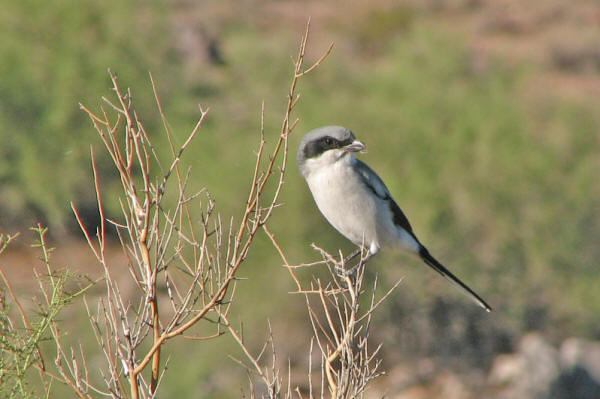
Loggerhead Shrike, the ninja of the Sonoran Desert
This bird is a skilled killer, specializing in taking down birds it own size and smaller. Several years ago I saw a Shrike ambush and kidnap an Inca Dove, and then quickly kill it. It was fast and stealthy, and caught us all by surprise (me and the other birds). The Dove was about the same size as the Shrike, maybe a little smaller.
My reaction at the time is rather humorous looking back. I immediately got angry, and wanted to rescue the Dove. After a few minutes of watching the process, I realized that this is nature being nature. As harsh as it is watching an innocent little dove being killed in such a Ninja manner, it is simply another part of the great balance within creation. It was a most impressive strike. True Beauty.
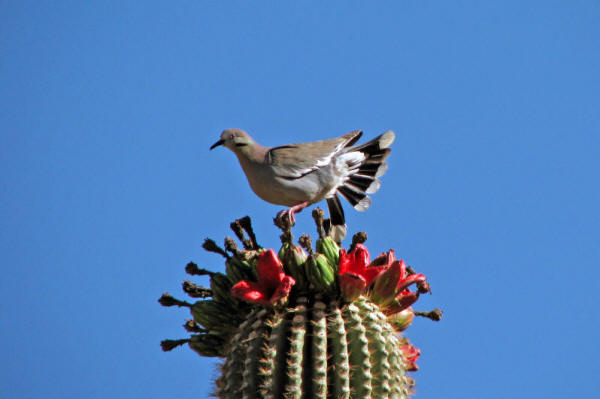
White-winged Dove, flashing some tail.
Is this Dove showing off her beauty for the camera? Nah, she was using what she's got to keep her balance on a windy day. Like most desert animals, these birds have incredible balance, far superior to humans. Even in the wind they rarely ever take a step to save it.
This is a good representation of the split-second moments that pass us by, day after day. They are just too fast and too many to keep up with. It takes something like stop-motion art to enable us to examine and experience the deep beauty that surrounds us in everyday things.
What a fun encounter this morning when I came across a pair of beautiful Coyotes meandering along. I can't remember when I have had such a relaxed experience with this canine species. After I happened upon them, they slowly walked off, without the usual alarmed trot that we humans normally get when we cross paths.
The bottom one had one of the richest coats that I have ever seen. He(?) even has a fox-ish look to him.
It was great to see two healthy and seemingly contented Coyotes in The Park. It is a good sign that all is well with the eco system.
Thanks for taking your time with me today.
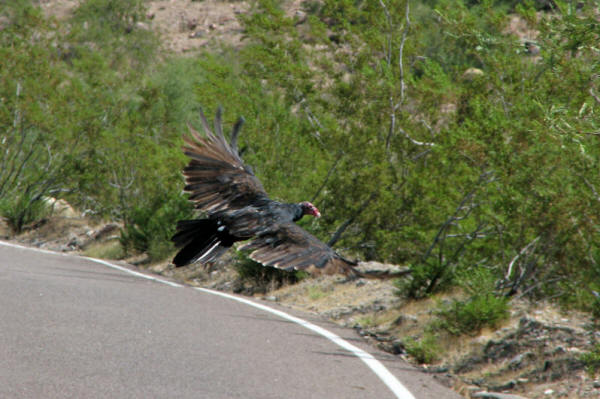
Turkey Vulture
This great bird was working at the entrance of Phoenix Mountains Park, cleaning up what appeared to be a Ground Squirrel that had been hit by a car. I was amazed by the size of this creature, looking to stand more than 3 feet tall. I love watching them fly...so grand and graceful. I was able to experience these flights several times...as cars would approach he(?) would launch clear, then circle around and land again. It reminds me of a 747, where it needs lots of room to make its turns and approaches, and the take offs were so slowish.
Another great animal graces the park. Thank you.
all images on this page copyright 2008, 2009
Email address Joe(at)AZJoe.com
